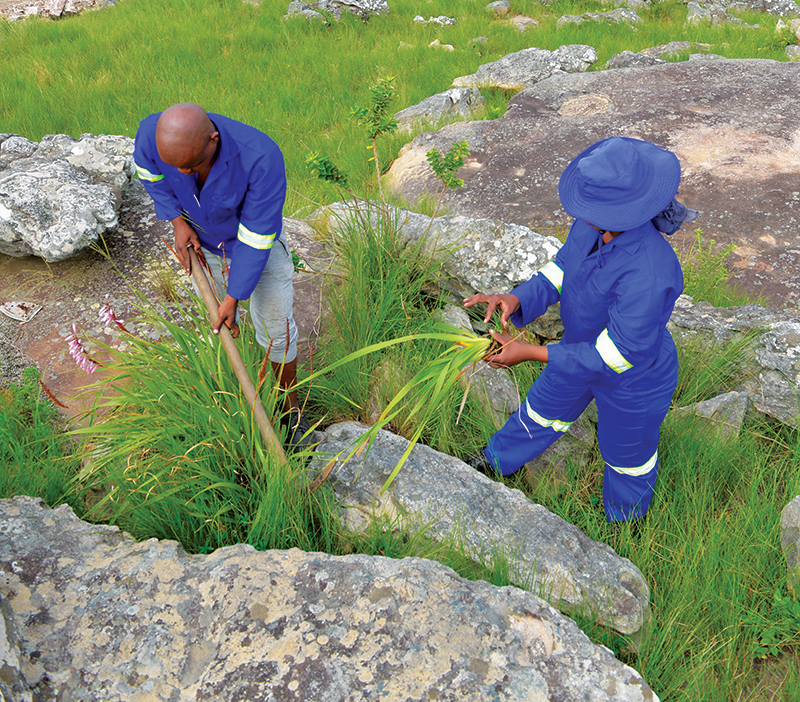Harmonising with
the environment
T he impact of road construction on the environment and natural resources is a high priority for SANRAL when new roads are planned or existing ones upgraded.
The development of road infrastructure is vital to economic progress and socio-economic wellbeing. Yet such activities have inevitable impacts on the natural environment and measures are taken to ensure sustainable development.
Through the years, SANRAL has built an enviable track record of responsible management of the natural environment. It goes the extra mile to conserve fauna and flora that might be disturbed by construction activities and is working closely with communities and researchers to preserve valuable cultural and archaeological sites.
1 The construction of the Musina Ring Road in Limpopo required the relocation of several ancient and very large baobab trees. None of the trees were lost and all are now thriving in their new locations.
2 When the N2 near Empangeni was upgraded to a dual carriageway the construction footprint was reduced to protect sensitive mangrove, woodland and dryland forests. Silt traps and sandbags were used to protect water quality and at least 20% of the construction material consists of reclaimed asphalt.
3 The upgrading of the Gwaing Bridge near George in the Western Cape was accompanied by the successful relocation of protected species, including 35 trees earmarked for replanting after the project is completed.
4 During the resurfacing of the N2 between Riviersonderend and Swellendam biodiversity was protected through the relocation of a range of indigenous plants.
5 Projects on the N7 near Kalbaskraal, Malmesbury and Hopefield required careful management of scarce water resources in a part of the country afflicted by a severe drought.
6 On the N2 Wild Coast project, team members identified and tagged vulnerable flora. Where whole plants could not be rescued, seeds were taken and replanted in temporary holding areas. More than 30 000 plants were rescued in the Mtentu and Msikaba areas.
7 Elsewhere on the N2 Wild Coast Road, water wastage is managed, oil is being recycled and steps are taken to minimise the use of plastic.
8 Independent experts conducted studies on the potential negative impact of blasting activities on a Cape Griffon vulture colony in the Msikaba Gorge. The study shows no negative impact on the breeding vultures.
9 During work done in the Abel Erasmus Pass in Limpopo, SANRAL contractors used sustainable construction methods that contributed to water savings of 71%.
10 On the R24 near Rustenburg in the North West indigenous trees – including Aloe, White Stinkwood and Bushwillow species – were planted to improve the natural environment.

Before construction starts
D etailed environmental impact assessments are conducted prior to the start of any SANRAL construction project.
The agency commissions independent studies and engages with a wide range of interested parties on the potential impact of a development. The feedback is incorporated in the design and execution of the projects.
In 2017/18 SANRAL received three environmental authorisations for new road projects. On the R510 that runs from the North West provincial border to Bierspruit in Limpopo, assessments were done to identify the potential impact of construction on streams and drainage lines.
Following an extensive public participation process environmental green lights were given for two proposed ring roads on the N2 in the Eastern Cape – at Butterworth and Idutywa.
Eight specialist reports were undertaken to deal with air quality and aquatic systems, vegetation and biodiversity, heritage and palaeontological resources, socio-economic issues, town planning and land uses.
A study is under way relating to the proposed upgrade of the R37 from Modikwa Mine to Burgersfort in Limpopo. The plans will mitigate concerns about the impact of construction on the Steelpoort River and marula trees situated in the road reserve.

BUILDING SOUTH AFRICA THROUGH BETTER ROADS
People's Guide 2018